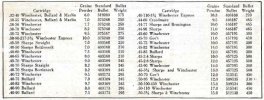Elric
Well-Known Member
Guns Magazine, June 1961, pages 12-13, 46
NOTE: Folks, this comes from a period article from June of 1961. At that time, it was viewed as reasonable. We are now over 60 years later, and this suggested loading data might or might not be published in current reloading manuals. I make no guarantee of the suitability of any of the listed loads. Use at your own risk.
" What powder should be used? Most of today's smokeless rifle powders are not at all compatible in rifles of 1870-1900 vintage. On the other hand, why use black powder? It has no real advantages, but presents problems of fouling, messiness, and laying down a smoke screen, which are not necessary.
The one powder that works well in all of these rifles is Unique. It develops low pressures, is easy to handle, and does not make you unpopular at the range. What is more, it is extremely economical.
Unique came out in 1898. It has been successfully used since then in practically every cartridge and is also good for blasting tree stumps. It is a fast burning powder of the double base type, primarily used in heavy revolver loads and reduced loadings of big bore rifles."
NOTE: I am NOT going to waste my Unique "blasting tree stumps".

"Try to pick a bullet for your rifle which is as near to the original factory bullet as possible. For example, if you own a Winchester M'76 chambered for the .45-60, the correct bullet is Lyman's #457191. This bullet weighs the same, and is roughly the same shape as the original factory bullet."
"Powder charges, according to bore diameter are listed in the table following. All loads are for Unique only! These are all suggested loads which are well below maximum. Loads are for the standard bullet weight in a given caliber. With these loads in mind, the reloader may experiment to find the best load for his particular rifle. Powder charges should never be raised more than 1/2 grain at a time. Keep in mind that most of these rifles were designed to operate at a pressure of 25,000 pounds or less."
"The suggested loads give roughly 11,000 psi. in straight cases 2" in length, with slightly lower pressures in bottleneck or longer cases of the same caliber."
NOTE: I thought a bottleneck case would have HIGHER pressures than a straight wall case.
NOTE: Folks, this comes from a period article from June of 1961. At that time, it was viewed as reasonable. We are now over 60 years later, and this suggested loading data might or might not be published in current reloading manuals. I make no guarantee of the suitability of any of the listed loads. Use at your own risk.
" What powder should be used? Most of today's smokeless rifle powders are not at all compatible in rifles of 1870-1900 vintage. On the other hand, why use black powder? It has no real advantages, but presents problems of fouling, messiness, and laying down a smoke screen, which are not necessary.
The one powder that works well in all of these rifles is Unique. It develops low pressures, is easy to handle, and does not make you unpopular at the range. What is more, it is extremely economical.
Unique came out in 1898. It has been successfully used since then in practically every cartridge and is also good for blasting tree stumps. It is a fast burning powder of the double base type, primarily used in heavy revolver loads and reduced loadings of big bore rifles."
NOTE: I am NOT going to waste my Unique "blasting tree stumps".

"Try to pick a bullet for your rifle which is as near to the original factory bullet as possible. For example, if you own a Winchester M'76 chambered for the .45-60, the correct bullet is Lyman's #457191. This bullet weighs the same, and is roughly the same shape as the original factory bullet."
"Powder charges, according to bore diameter are listed in the table following. All loads are for Unique only! These are all suggested loads which are well below maximum. Loads are for the standard bullet weight in a given caliber. With these loads in mind, the reloader may experiment to find the best load for his particular rifle. Powder charges should never be raised more than 1/2 grain at a time. Keep in mind that most of these rifles were designed to operate at a pressure of 25,000 pounds or less."
"The suggested loads give roughly 11,000 psi. in straight cases 2" in length, with slightly lower pressures in bottleneck or longer cases of the same caliber."
NOTE: I thought a bottleneck case would have HIGHER pressures than a straight wall case.
Last edited:
